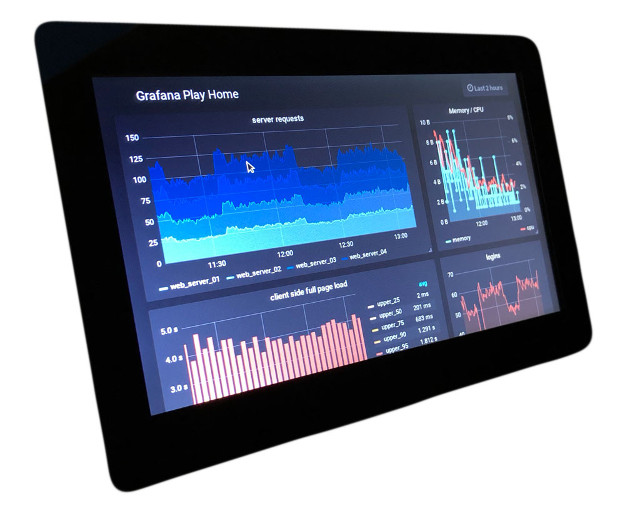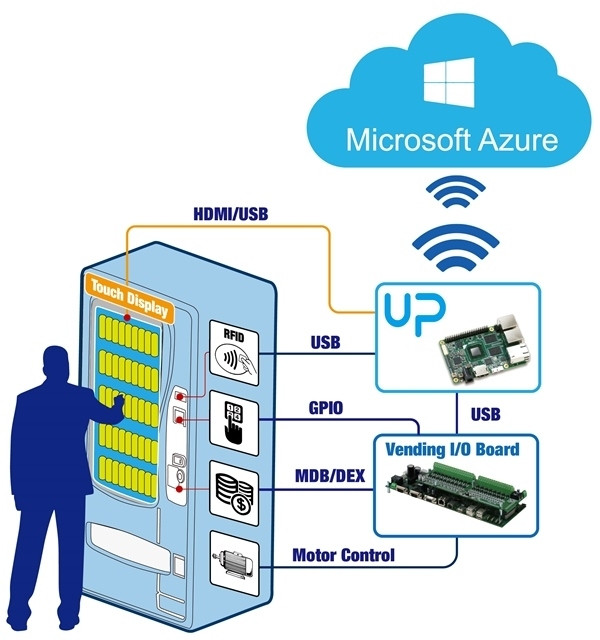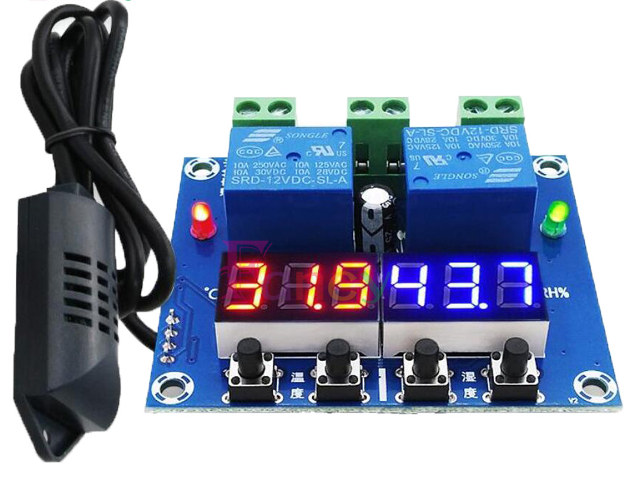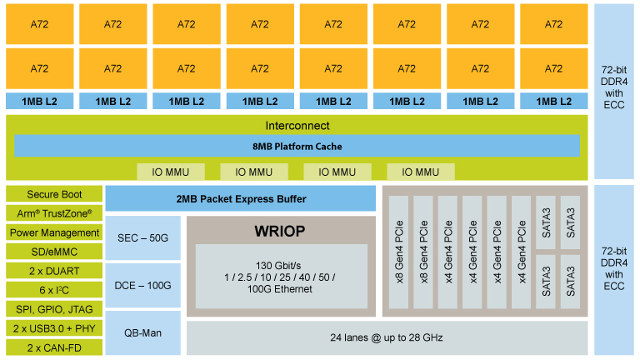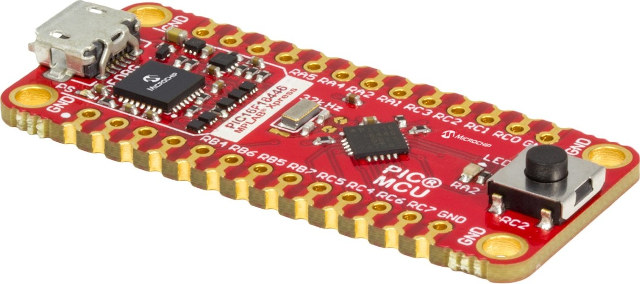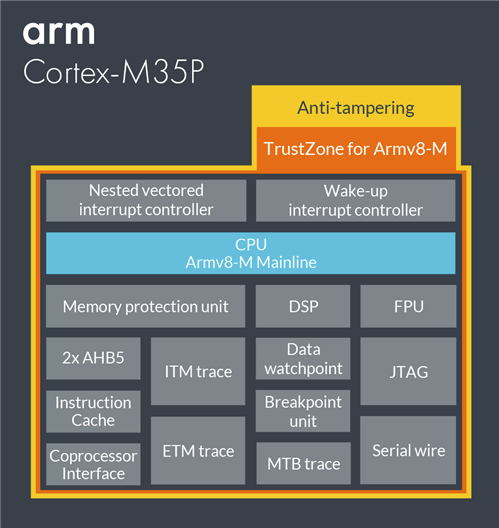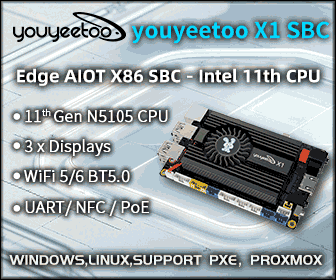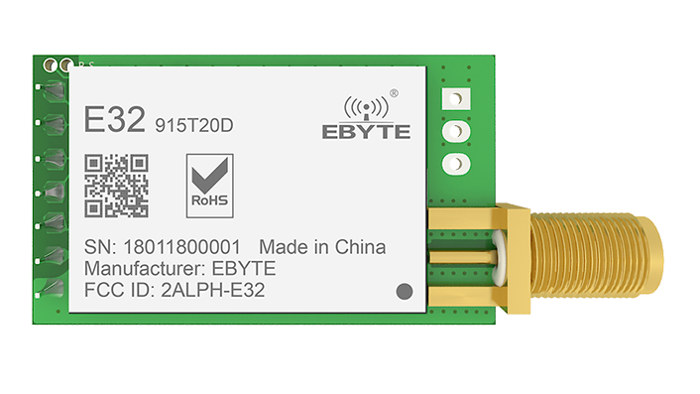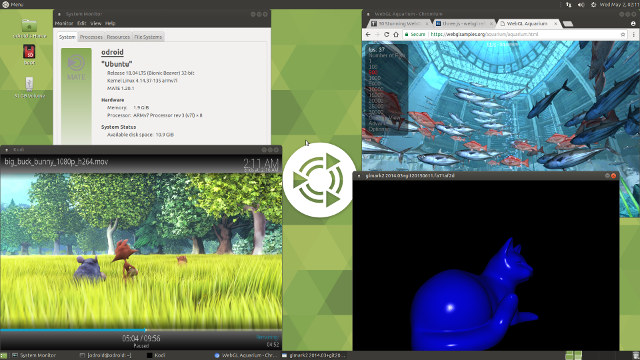After their first Raspberry Pi Compute Module 3 based board called CM3-Home designed for home automation, Acme Systems has designed a new RPi CM3 carrier board called CM3-PANEL for panel PCs / tablets. They sell four variants of their panel PC built around the board with or without WiFi module and/or 868MHz RF module, and offer customization services for people willing to purchase at least 100 pieces. CM3-PANEL based Panel PC specifications: Socket for Raspberry Pi Compute Module 3 Display – 7″ (800×480 resolution) with 10-point capacitive touch Camera – MIPI connector for Raspberry Pi Camera Up to 24 GPIO lines available for extensions or LCD backlight control Camera led and camera shutdown control SPI bus (5 GPIOs) Hardware PWM lines (2 GPIOs) Serial line PCM line (4 GPIOs) I2C bus Model specific features: CM3-PANEL-W – 802.11 b/g/n WiFi @ 2.4GHz (RaLink RT5370N USB module) CM3-PANEL-U – 1x USB host […]
AAEON Releases an Intelligent Vending Machine Development Kit based on UP Board
UP board is a low cost development board powered by an Intel Atom x5-Z8350 Cherry Trail processor with 1GB to 4GB RAM, and 16 to 64GB eMMC flash that mostly follows Raspberry Pi 3 form factor. AAEON is now offering an “intelligent vending development kit” featuring UP board together with a vending machine controller (VMC) board, a motor for the machine’s internal mechanisms, a camera, a QR Code device, and all the necessary cables, as well as optional WiFi and Bluetooth modules. Some details about AIOT-MSSP01 Mini SSP Vending control board: “Intel Intelligent Vending Based” Motor Control – 24V or 12V, Supports GPIO, DC, PWM Type, Supports up to 160 DC Motors Support LCD and Keypad Feature I/Os Vending machine specific interfaces / standards 1x MDB (MultiDrop Bus) 1x DEX (Digital EXchange) 1x Protocol A (EXE) 1x 1-WIRE 4-channel ADC x 1 4-channel Relay GPIO for 12V & 5V by […]
XH-M452 Board Helps Controlling a Cabinet or Room’s Temperature & Humidity
XH-M452 is a board designed to control the temperature and humidity in a room or cabinet. It comes with two relays to control appliances like fans, air conditioners, (de-)humidifiers, or heaters, and ships with a temperature and humidity probe attached to a one meter cable. XH-M452 board specifications: “ST Controller” Relays – 2x SONGLE 10A/250VAC 125VAC relays for temperature control (left) and humidity control (right). Display – 2x LED display for temperature & humidity Sensor 1 meter probe for temperature & humidity Temperature range – -20 to 60°C +/- 0.1°C Humidity range – 0% to 100% RH +/- 0.1% RH Misc – +/- buttons to adjust temperature and humidity; 2x relay status LEDs. Power Supply – 12V via terminal Dimensions – 65 x 55 x 28mm You’ll need to provide a 12V power source for the board, connect an appliance to control the temperature on the left terminals, and an […]
NXP QorIQ LayerScape LX2160A is a 16-core Arm Cortex A72 Communication Processor with 100 Gbit/s Ethernet
NXP Semiconductors has been working on a high-end communication processor with their QorIQ LayerScape LX2160A SoC equipped with 16 Arm Cortex A72 cores, 16 Ethernet ports supporting 1 to 100 Gbit/s, as well as 24 PCIe Gen4 lanes, and four SATA 3.0 ports. NXP LX2160A key specifications / features: Processor – 16x Arm Cortex-A72 CPU cores, running up to 2.2GHz with 8MB L2 cache, 8MB platform cache Memory I/F – 2 x DDR4 72b including ECC, up to 3200 MT/s, maximum capacity of 256 GB Storage – 4 x SATA3.0 Ethernet Up to 16 Ethernet ports Supported Ethernet speeds include 1, 2.5, 10, 25, 40, 50, and 100 gigabits per second 130Gbps Layer 2 Ethernet switch PCIe – Up to 24 PCIe Gen4 lanes, supporting ports as wide as x8 24 SerDes lanes, operating up to 28GHz Acceleration Engines – 50Gbps security accelerator, 100Gbps data compression/decompression engine Security – Secure […]
Microchip Offers Free PIC16F18446 8-bit MCU Development Boards
Microchip announced several PIC and AVR microcontrollers with “Core Independent Peripherals and Intelligent Analog” in February with respectively PIC16F18446 family of microcontrollers, and ATmega4809 megaAVR microcontrollers, with the latter to be integrated in the next generation of Arduino boards. The company is now organizing a promotion for their PIC16F184xx product family where they give away a PIC16F18446 MPLAB Xpress evaluation board! Key features of PIC16F184 micro-controllers: High-precision 32 MHz internal oscillator 7 to 28 KB Flash program memory 512 bytes to 2 KB of SRAM 12-bit ADC with computation (ADC2), up to 24 channels 5-bit DAC eXtreme Low Power (XLP) with sleep currents down to 50 nA IDLE and DOZE low power modes Memory Access Partition (MAP) Device Information Area (DIA) Signal Measurement Timer (SMT) Hardware Limit Timer (HLT) Windowed Watch Dog Timer (WWDT) Peripheral Pin Select (PPS) Peripheral Model Disable (PMD) Configurable Logic Cell (CLC) Two comparators Numerically Controlled Oscillator […]
Arm Cortex M35P Armv8-M MCU Core Gets Physical Security with Anti-tampering Features
Armv8 and Armv8-M processor already support Arm TrustZone security, which aims to prevent software attacks against the target device. However, if a hacker has physical access to the hardware, it may not be sufficient to prevent hacking. Arm Cortex-M35P core addresses this issue by providing physical (hence the P in the name) security with anti-tampering features that protect against access even with direct access to the hardware. Highlights of the processor: Architecture – Armv8-M Mainline (Harvard) ISA Support – Thumb/Thumb-2 Pipeline – Three-stage Software security – Optional TrustZone for Armv8-M, stack pointers checking Physical security – Built-in protection from invasive and non-invasive attacks DSP Extensions Optional DSP/SIMD instructions Single cycle 16/32-bit MAC Single cycle dual 16-bit MAC 8/16-bit SIMD arithmetic Floating Point Unit – Optional single precision floating point unit,IEEE 754 compliant Co-processor interface – Optional dedicated co-processor bus interface for up to 8 co-processor units for custom compute Memory […]
Ebyte Offers Low Cost Wireless Modules for LoRa, Zigbee, NB-IoT, Bluetooth, and More
Chengdu Ebyte Electronic Technology Ltd (or just Ebyte for short) is a company based in Western China that design and manufacturer low cost wireless modules for LoRa, WiFi, Bluetooth, Zigbee, NB-IoT & GPRS cellular connectivity, many of which appear to be FCC certified. The list of modules is way too long, so I’ll just have a look at two products from the company: Ebyte E32-915T20D LoRa 915 MHz module and Ebyte ME3612 NB-IoT wireless module. Ebyte E32-915T20D LoRa 915 MHz module Specifications: Connectivity Semtech SX1276 LoRa 900~931MHz (default: 915 MHz), 32 channels Range – up to 3 km with 20 dBm power, 5 dBi antenna Data rate – 2.4 kbps (default), configurable to 0.3, 1.2, 2.4, 4.8, 9.6, 19.2 kbps Rx Sensitivity – -138dbm at 0.3kbps Expansion – 7-pin header 2.54mm pitch with UART, USART host interface Power Supply – 2.1 to 5.5V DC Power Consumption – Standby: 2.0 uA; Tx: 120 mA […]
Hardkernel & Libre Computer Release Ubuntu 18.04 Images for ODROID-XU4/3 & AML-S905X-CC Boards
Ubuntu 18.04 “Bionic Beaver” LTS operating system was released just last week, and at least two Arm board companies have independently released Ubuntu 18.04 images for their boards. First, Hardkernel has released an Ubuntu 18.04 MATE image for their Exynos 5422 powered ODROID-XU4(Q), ODROID-XU3 (Lite), ODROID-HC1, and ODROID-MC1 boards/kits. The ODROID Ubuntu image comes with the following key features: Linux 4.14.37 LTS GPU hardware acceleration via OpenGL ES 3.1 and OpenCL 1.2 drivers for Mali T628MP6 GPU FFMPEG/ffplay with hardware accelerated H.264 decoder X11 armsoc display driver with 2D acceleration GPU accelerated Chromium browser (WebGL contents and YouTube 720p plays well) Kodi 17.6 can play H.264 1080p/60fps BigBuckBunny sample video. (Note: no h.265, no 4K in Exynos-5422 processor) WiringPi and other GPIO/SPI/I2C/ADC/I2S tinkering libraries are available. KVM & Docker More stable and performant USB 3.0 and Gbit Ethernet drivers The company sent me a kit based on ODROID-XU4Q board to […]


